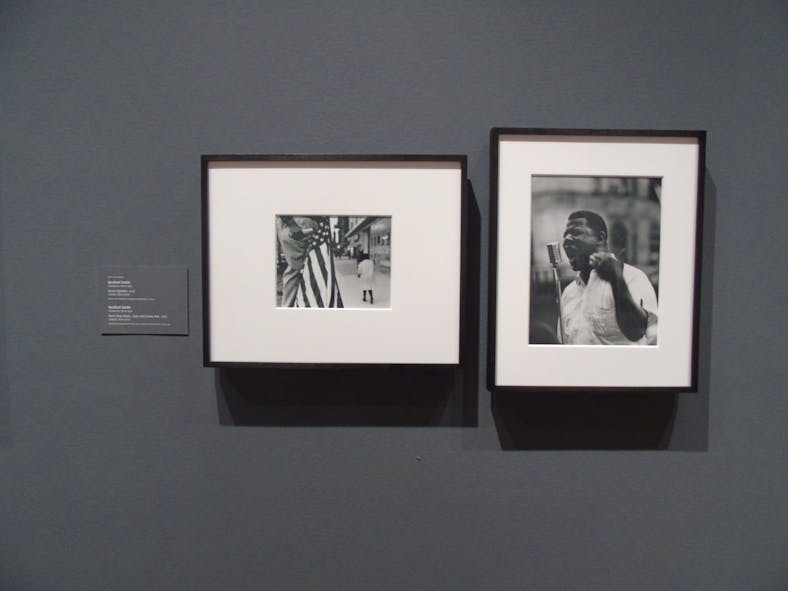More than 180 photographs capturing facets of African American life in New York during the 1960s and '70s are on display at the Virginia Museum of Fine Arts in the exhibit “Working Together: Louis Draper and the Kamoinge Workshop.”
“These amazingly talented photographers were more or less ignored in the larger art world, but I can tell you that stops now, because this exhibition is changing that with an amazing dialogue to bring them the recognition that they’ve long been due,” Alex Nyerges, the VMFA Director, said.
Sarah Eckhardt, the exhibit curator, echoed this sentiment.
“If there was a thesis of this exhibit I would say that any history of photography about 1960s and 1970s United States of America would not be complete without pieces from the Kamoinge Workshop," she said.
The Kamoinge Workshop is a group of African American photographers founded in New York City in 1963 with the help of Richmond native photographer Louis Draper. This free exhibit at the VMFA will be on display until June 14, and it includes photographs from 15 of the early members of the group and their photography illustrates the first 20 years of the workshop’s history.
University of Richmond President Ronald A. Crutcher and Betty Neal Crutcher are sponsors of the exhibit, among others. This exhibit is one of multiple that the VMFA will be hosting during Black History month and throughout the spring.
Lauranett Lee, a visiting professor at the Jepson School, said students should be particularly interested in the exhibit because it would be an opportunity to break out of UR’s campus bubble and to witness life in a very personal way.
The images are timeless, stark, evocative and informative, she said.
The exhibit displays photographs chronologically from the beginning of Kamoinge through photography from civil rights protests in Alabama and Mississippi, and ends with 4-minute video interviews of each member of Kamoinge. One photo in the Civil Rights section depicts an African American man yelling into a microphone with his hand in the air.

Beuford Smith's photographs of civil rights protests.
Beuford Smith, one of the original members of Kamoinge, attended the press preview of the exhibit on Jan. 30. His work, displayed throughout the exhibit, is abstract in type but also includes some portrait photography.
Smith became a member of Kamoinge in 1965 through Roy DeCarava, an artist who is an original member of Kamoinge with Draper.
Enjoy what you're reading?
Signup for our newsletter
“It was a family and a lot of photographers wanted to become members because it was a black family," Smith said.
Smith also described the influence Kamoinge had on other black photographers and social civil rights during the '60s and '70s.
“The group Kamoinge took [photography] to another level: It was about black history, but it was also abstract,” Smith said. “I was enriched by being introduced to them.”
The word Kamoinge means “a group of people acting and working together” in Gikuyu, which is the language of the Kikuyu people of Kenya, according to the VMFA’s description of the exhibit. The group's meetings often consisted of them critiquing each other's work and working together to curate their own exhibits, Smith said.
Eckhardt quoted Draper from his archives to emphasize the significance of Kamoinge’s formation at the height of the Civil Rights Movement: “Cognizant of the forces for change revolving around Kamoinge, we dedicated ourselves to speak our lives as only we can,” Draper wrote.
“This was our story to tell and we set out to create the kind of images of our communities that spoke of the truth we’d witnessed and that countered the untruth we’d all seen in mainline publications,” Draper wrote.
Eckhardt said there was significance in Kamoinge first being displayed in Richmond before moving to the Getty Museum in Los Angeles, California, and other museums. She said she had wanted to honor Nell Draper Winston’s, Louis Draper’s sister, desire for her brother to be better known in his hometown.
Eckhardt also had a sense that the timing of Draper’s leaving for New York as a college senior in 1957 wasn’t a coincidence based on her observations of his writings and work.
“This was at the height of massive resistance and Brown v. Board of Education, and I don’t believe that he just happened to discover the power of photography during this time,” Eckhardt said. “There was a shift that happened for him between understanding political representation and visual representation, and he realized he could use photography as his tool.”
Along with the exhibit being open until June, the VMFA and the Institute for Contemporary Art at VCU are collaborating to host a symposium on March 20 and 21. It is titled “The Kamoinge Workshop: Collaboration, Community and Photography” and is also a free, ticketed event.
“We are working to do these things around the year, but also to honor Black History Month,” Eckhardt said.
A full list of events being hosted at the VMFA during Black History Month can be found on its website.
UR students can access the museum by taking the Willow Lawn Xpress to the Libbie/York stop and connecting with GRTC Bus 77.
Lee said the exhibit would speak not only on the past but also to the present, and it would be beneficial to students to learn about the history of their local city.
Contact international editor Emma Phelps at emma.phelps@richmond.edu.
Support independent student media
You can make a tax-deductible donation by clicking the button below, which takes you to our secure PayPal account. The page is set up to receive contributions in whatever amount you designate. We look forward to using the money we raise to further our mission of providing honest and accurate information to students, faculty, staff, alumni and others in the general public.
Donate Now



